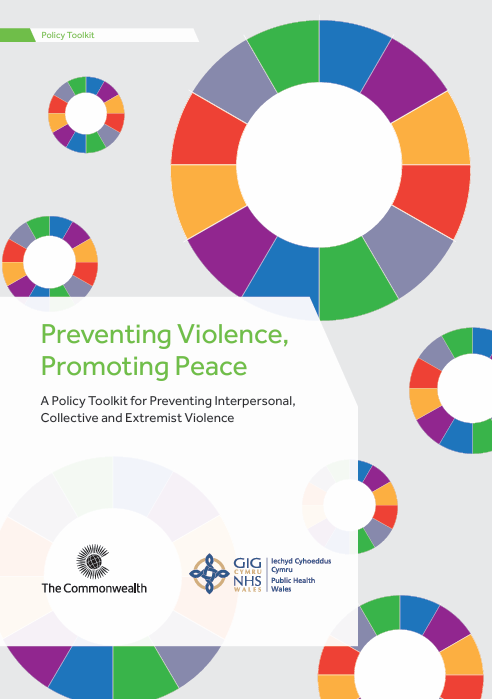A policy toolkit to prevent violence. It adheres to the Commonwealth Charter’s principles of international peace and security, sustainable development, and the rule of law. Offers evidence-based prevention strategies to address the root causes of violence in line with the Peace-Building Commonwealth theme. It stresses the need to break cycles of violence and inequality to foster sustainable development.
Key Findings
- Global Impact of Violence: Approximately 580,000 violence-related deaths globally in 2015. It emphasizes the economic impact of violence, which costs 13.3% of global productivity or US$13.6 trillion yearly, with the Commonwealth bearing around US$1.4 trillion annually.
- Economic and Social Consequences: Early exposure to violence leads to challenges in education, employment, and mental and physical health. This strains health, social, and legal systems, perpetuating poverty, inequality, and increasing violence risks.
- Infectious Nature of Violence: Highlights how exposure to violence can turn children into future victims or perpetrators, perpetuating a cycle across generations. Hence, breaking this cycle is crucial to eliminate violence.
- Prevention Strategies: Focuses on violence prevention by addressing poverty and inequality, contributing to marginalization and feelings of injustice. It emphasizes the challenge of balancing individual freedoms with state or parental regulation, particularly concerning global corporations.
Overview
Introduction
Underscores modern challenges to worldwide peace and sustainable development, including conflict, mass migration, globalization, and inequality, which fuel global violence cycles. This document informs a Commonwealth action plan for violence prevention, a joint effort between the Commonwealth Secretariat and Public Health Wales.
- The target audience consists of heads of Government, ministers of health and foreign affairs, and individuals involved in violence prevention efforts.
- The document adopts a public health approach to violence prevention, focusing on identifying risk factors and evidence-based measures to address them at a population level.
- It covers various forms of violence, including interpersonal violence, collective violence (war and gang violence), radicalization, and violent extremism, emphasizing the interconnectedness and shared risk factors among these forms.
- The document is organized into six sections, covering the extent of violence globally, its impacts on health and society, risk factors for violence, effective prevention strategies, and key recommendations.
The extent of the problem
Analyzes the global prevalence and impact of violence, including child maltreatment, gender-based violence, elder abuse, youth violence, radicalization, and violent extremism. It highlights the significant economic, social, and health effects of violence, stressing the need for comprehensive prevention strategies. The section emphasizes the urgency of addressing violence’s complex challenges through coordinated and evidence-based interventions.
- Statistics and data on the prevalence of different types of violence showcase the widespread nature of the problem.
- The detrimental effects of violence on individuals, communities, and societies include physical health consequences, life course impacts, strain on health services, economic repercussions, and social implications.
- The interconnectedness of violence with broader issues such as poverty, inequality, conflict, and migration exacerbate cycles of violence and hinder sustainable development efforts.
- The importance of understanding the root causes and risk factors for violence is to develop effective prevention measures that target these underlying drivers.
Understanding the broader impacts of violence
Examines the extensive effects of violence on individuals, communities, and societies. It discusses how violence impacts physical health, mental well-being, social unity, and economic stability. Due to these widespread effects, the section stresses the need for comprehensive prevention strategies. It emphasizes the link between violence and various individual and societal well-being elements. This highlights the need for a holistic approach to preventing violence, one that considers its diverse effects on health, social relations, and economic growth.
- The physical health consequences of violence include injuries, disabilities, reproductive health issues, mental health disorders, and increased risks of communicable diseases.
- The life course impacts of violence highlight how experiences of violence in childhood can lead to long-term negative outcomes such as antisocial behavior, educational and employment challenges, and early onset of chronic diseases.
- The strain on health services due to treating immediate injuries and long-term consequences of violence results in significant healthcare costs and challenges for healthcare providers, especially in conflict-affected areas.
- The broader economic consequences of violence include direct costs to health, social welfare, and legal systems and indirect costs such as damage to businesses and local economies.
- The social impacts of violence on public health, such as effects on self-esteem, trust, relationships, social isolation, and community cohesion, as well as implications for education, employment, and human rights violations.
Risk factors for violence
Inspects the factors contributing to violence at personal, community, and societal levels. Recognizing these risk factors enables policymakers and practitioners to devise specific interventions for violence prevention and peace promotion. It underscores the complex connection between personal vulnerabilities, societal aspects, and mental health issues in assessing the risk of violence. Stakeholders can aim to prevent violence and encourage peace in communities by implementing targeted interventions and policies that address these risk factors.
- Individual vulnerability and resilience across the life course: Individuals with personal and family histories characterized by instability, dysfunctional backgrounds, experiences of violence, mental health issues, substance abuse, and other challenges are at higher risk of perpetrating or experiencing violence.
- Global and societal factors: Macro-level factors such as poverty, economic and social inequalities, cultural norms supporting violence, corruption, conflict, urbanization, population demographics, and migration play a significant role in shaping the risk of violence within communities.
- Social impacts of violence on public health: Violence can impact individuals’ self-esteem, trust, relationships, social cohesion, and life prospects, particularly affecting children and young people’s educational outcomes, employment opportunities, and social integration.
- Mental health and violence: There is a link between mental health conditions and violent behavior, with individuals with certain psychiatric conditions being at higher risk of perpetrating violence. Mental illness can also be a risk factor for child maltreatment and other forms of violence within families.
What works to prevent violence
Focuses on effective strategies and interventions for preventing violence at individual, community, and societal levels. It aims to guide policymakers and practitioners in implementing successful violence prevention programs by showcasing evidence-based approaches. The emphasis is on early intervention and addressing underlying risk factors to prevent violence and foster community peace. Comprehensive strategies that target multiple levels of influence can help stakeholders create safer, more resilient societies.
- Tackling poverty and inequalities: Addressing root causes such as poverty, economic disparities, and social inequalities is essential for violence prevention. Effective prevention programs often rely on establishing supportive social, political, and economic structures to facilitate their implementation.
- Youth violence prevention programs: Interventions targeting youth violence play a crucial role in preventing violence at an early stage. These programs may focus on education, skill-building, mentorship, conflict resolution, and community engagement to address risk factors and promote positive youth development.
- Mental health and violence: Recognizing the link between mental health conditions and violent behavior is crucial for developing targeted interventions that support individuals with mental health challenges and reduce the risk of violence.
- Social and cultural norms: Addressing norms supporting violence and promoting positive social behaviors can create safer and more peaceful communities.
- Family violence prevention: Interventions that address family violence, promote healthy relationships, and provide support for individuals experiencing violence within families are essential for preventing further harm and breaking the cycle of violence.
Summary and recommendations
Provides a detailed overview of the main findings and practical suggestions for preventing violence and promoting peace. It deciphers the document’s primary insights, steering policymakers, practitioners, and stakeholders toward effective strategies for handling violence at diverse levels. It guides stakeholders to carry out evidence-based interventions, tackle the roots of violence, and build peaceful, resilient communities. By adhering to these recommendations, policymakers and practitioners can strive to generate a safer, more peaceful world for everyone.
- Recognition of evidence-based public health approaches: Acknowledges the emergence of evidence-based strategies for preventing interpersonal violence and emphasizes the importance of understanding risk factors at individual, relationship, community, and societal levels.
- Interconnected nature of violence: Highlights the cyclical nature of violence, where children exposed to violence are more likely to perpetrate or experience violence in the future, underscoring the need for early intervention and prevention efforts.
- Recommendations for action: Collaborative planning, a public health approach to violence prevention, promoting gender equality, addressing poverty and inequalities, youth development support, and training on violence prevention across sectors are recommended.
Henceforth. Moreover. Furthermore. Nonetheless. Nevertheless. Henceforth. Moreover. Furthermore. Nonetheless. Nevertheless. Henceforth. Moreover. Furthermore. Nonetheless. Nevertheless. Henceforth. Moreover. Furthermore. Nonetheless. Nevertheless. Henceforth. Moreover. Furthermore. Nonetheless. Nevertheless. Henceforth. Moreover. Furthermore. Nonetheless. Nevertheless. Henceforth. Moreover. Furthermore. Nonetheless.




